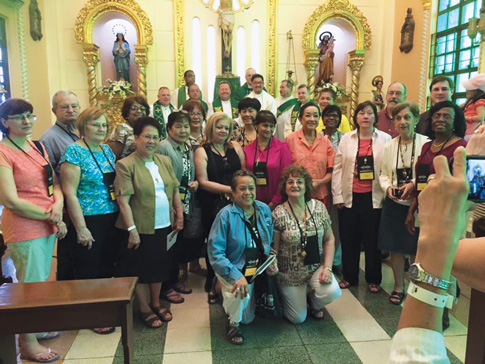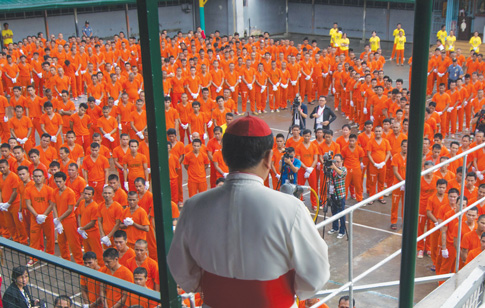By Shirley Figueroa Lascano

I was blessed and grateful to be among the pilgrims from Brooklyn and Queens who travelled to the Philippines for the 51st International Eucharistic Congress in the Philippines.
One of the first places we visited was the site of Ferdinand Magellan’s Cross where Christianity arrived on the island of Cebu in 1521. Magellan’s expedition offered a cross to King Humabon of Cebu. The royal family later was baptized together with their 800 subjects by Father Pedro Valderrama.
We celebrated our first Mass at the Archbishop’s Palace. Brooklyn Auxiliary Bishop James Massa was the celebrant. Msgr. Kieran Harrington, rector of the Co-Cathedral of St. Joseph, Prospect Heights; Father Gerard Sauer, pastor of St. Mel’s parish, Flushing; Father Patrick Longalong, coordinator for the ministry to Filipino immigrants; and Father Kevin McBrien, pastor of Our Lady of the Snows, North Floral Park, were among the concelebrants. Deacon Jaime Varela, personal secretary to Bishop Nicholas DiMarzio, assisted at the altar.
Diocesan pilgrims also had an opportunity to participate in a Mass at the Basilica of Santo Niño. Each of us received a personal opportunity to venerate the image of Santo Niño together with the hospitality of a delicious lunch.
Snow in New York could not stop the arrival of Cardinal Timothy Dolan. He joined us as the main celebrant of a liturgy at the Metropolitan Cathedral.
Cardinal Dolan’s homily was centered on God’s generosity. He said, “God is never outdone in His generosity.” In as much as David was so busy in search for a house for the Lord, God told David, “I will do something for you; I will build you a house, a kingdom and from you will come the greatest kingdom I will build.”
The cardinal was impressed by the Cebu Cathedral and also when he had an opportunity to visit the Basilica of Santo Niño. He enjoyed the gracious hospitality of the Filipino people, exemplified by their astounding friendship and warmth. He said it reminded him that the Eucharist is the center of our spiritual family which is the Church.
Bishop Massa “admired the way of reverence of the Filipino people when they come up to receive the Eucharist; their devotion to the different saints, most especially the Santo Niño; and their affirmation of one’s Catholic identity and the smiles on their faces.”
He recalled a trip he took to Iceland where a small parish of about a hundred people was being kept alive by Filipinos. He was very surprised since Iceland is historically Lutheran!
I reminded him of the comment made by the Papal Legate Cardinal Charles Maung Bo of Yangon, Myanmar, “Catholicism to us means Filipinos.”
Bishop Massa added that the Filipino Catholic community in the diaspora is keeping many parishes alive around the world.
When I asked him to describe the Filipinos. He replied, “Catholicism is in their blood.”
Those pilgrims who have a special devotion to Mary could not pass up the chance to join a pilgrimage to the Shrine of Our Lady of Simala, a two-hour trip from Cebu City. Many expressed surprise as to the beauty of the countryside and admired the people’s way of living. The pilgrimage was made possible by Sister Doryne Bermoy, F.L.P., and her family.

“Simala Shrine is technically a monastery of monks with a special devotion to the Blessed Mother. The place is still an ongoing construction. The history of this place was quite moving and inspiring,” said Father Longalong.
“Many years ago, prior to the construction of this magnificent structure, a plague of the Dengue Fever ravaged the village. The residents asked for Mary’s intercession by making a nine-day evening penitential procession with the image of Our Lady of Fatima accompanied by two torches. On the third day, they saw the image of Mary shed tears. The following days led to many miraculous cures and eventually the disappearance of the plague.
“Today, there are wall displays of the many thousands of letters sent to the monastery to give thanks to God and the intercession of Mary. Crutches and other medical devices were also displayed to remind pilgrims of immediate miraculous cures experienced at this site. People came in with crutches and left walking out unassisted.”
When we arrived back in Cebu City, it was time for the procession from the Capitol to Plaza Independencia. This was an amazing testament of Catholic faith with a huge monstrance and exposition of the Blessed Sacrament.
Cardinal Bo said, “The Eucharist of the disciples continues in the altar of the streets.”
On the final weekend of the pilgrimage, we participated in a Mass for 5,000 first communicants, celebrated by Archbishop Emeritus of Cebu, Cardinal Ricardo Vidal, who received his First Communion during the 33rd Eucharistic Congress, in the Philippines in 1937.
Bishop Massa was chosen to give First Holy Communion to some of the children. Also assisting were Fathers McBrien and Longalong.
Near the end of the Congress, Pope Francis spoke to the delegates via video.
His apostolic blessing to each one present touched me! He said, “As you now prepare to ‘go forth’ at the end of this Eucharistic Congress, there are two gestures of Jesus at the Last Supper which I would ask you to reflect on. Both have to do with the missionary dimension of the Eucharist. They are table fellowship and the washing of feet.”
As a participant in the Eucharistic Congress in my native land, it gave me goose bumps to be a part of this wonderful event in my faith.
Shirley Figueroa-Lascano is a member of St. Michael’s parish, Flushing.

Thank you for this very insightful report of our pilgrimage. You have given a beautiful, detailed account of our trip which made it very easy for me to remember and to dwell and feel the blessing bestowed upon us! I just want to remind you that there were also pilgrims from Westchester, New York and New Jersey who came along with us!